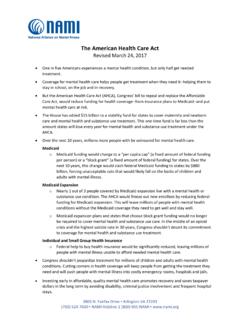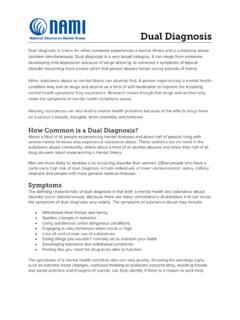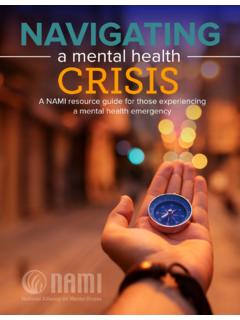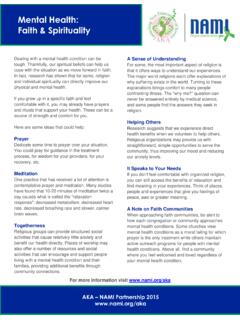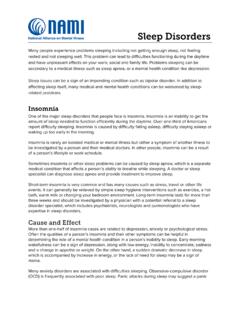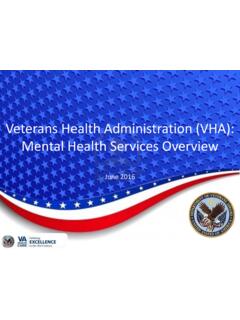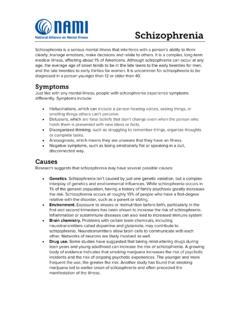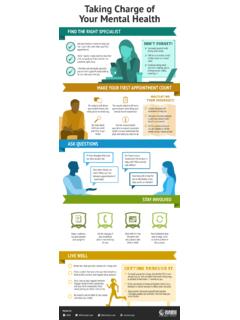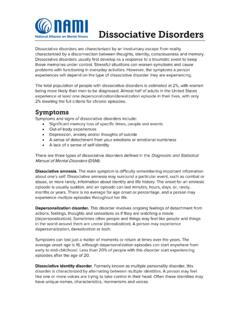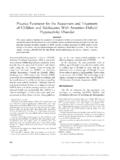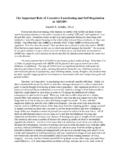Transcription of Attention deficit hyperactivity disorder (ADHD) is a ...
1 ADHD. Attention deficit hyperactivity disorder (ADHD) is characterized by inattention, hyperactivity and impulsivity. ADHD is most commonly diagnosed in young people, according to the Center for Disease Control and Prevention (CDC). An estimated 9% of children between ages 3 17 have ADHD. While ADHD is usually diagnosed in childhood, it does not only affect children. An estimated 4% of adults have ADHD. Symptoms While some behaviors associated with ADHD are normal, someone with ADHD will have trouble controlling these behaviors and will show them much more frequently. Signs of inattention: Becoming easily distracted and jumping from activity to activity Becoming bored with a task quickly Difficulty focusing Attention or completing a single task or activity Trouble completing or turning in homework assignments Losing things such as school supplies or toys Not listening or paying Attention when spoken to Daydreaming or wandering with lack of motivation Difficulty processing information quickly Struggling to follow directions Signs of hyperactivity : Fidgeting and squirming, having trouble sitting still Non-stop talking Touching or playing with everything Difficulty doing quiet tasks or activities Signs of impulsivity: Impatience Acting without regard for consequences, blurting things out Difficulty taking turns, waiting or sharing Interrupting others Causes There are several factors believed to contribute to ADHD: Genetics.
2 Research shows that a person's genetics may cause a high risk of developing ADHD which often runs in families and some trends in specific brain areas that contribute to Attention . Environmental factors. Studies show a link between a mother's cigarette smoking and alcohol use during pregnancy and children who have ADHD. Exposure to lead as a child has also been shown to increase the likelihood of ADHD in children. Diagnosis ADHD occurs in both children and adults, but is most often seen and diagnosed in childhood. Getting a diagnosis can sometimes be difficult because the symptoms are similar to typical behavior in most young children. Teachers are often the first to notice symptoms because they see children in a learning environment with peers every day. There is no one single test that can diagnose a child with ADHD, so meet with a doctor or mental health professional. The goal is to rule out any outside causes for symptoms, such as environmental changes, difficulty in school, medical problems and ensure that a child is otherwise healthy.
3 Treatment A treatment plan is most effective if it is uniquely tailored to an individual's needs, and if it is implemented early on. Treatment plans should take into consideration learning style and potentially include medication that can be prescribed by a pediatrician, general practitioner or mental health professional. Commonly prescribed medications include both stimulants and non-stimulants. While stimulants are usually the first choice for treating ADHD, antidepressants might be something a doctor suggests especially if someone is living with ADHD in addition to depression. If effective, medications can improve Attention span, the ability to deal with frustration and ultimately lead to better relationships with teachers, family members and peers. A doctor or mental health professional may also want to incorporate behavioral therapy into the treatment course. Having structure and routine, as well as clear expectations of what is allowed and not allowed in terms of behavior and outbursts can help a child learn and feel more in control of their own life.
4 Behavior therapy can also help improve social skills of people living with ADHD, such as sharing and interacting with peers. Complementary Health Approaches Elimination diets are based on the theory that people are sensitive to sugar and artificially added colors, flavors and preservatives, and that eliminating these substances from the diet could improve learning and behavioral problems. Nutritional supplements, such as omega-3s, are thought to help the deficiency of fatty acids that are sometimes associated with ADHD. Neurofeedback (EEG biofeedback) teaches individuals how to increase arousal levels in the frontal areas of the brain. This is because people living with ADHD. show low levels of arousal in these areas, which results in an impaired ability to focus. See more at: Updated March 2015. NAMI. 3803 N. Fairfax Drive, Suite 100. Arlington, VA 22203. NAMI HelpLine: 800-950-NAMI (6264). NAMI | namicommunicat
